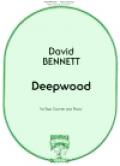Deepwood
Disclaimer
C.I.R.C.B. is not responsible for any material supplied by third parties. C.I.R.C.B. does not assume any legal liability for the consequences related to downloading material that is not in the public domain in your country. Always check before download, not to infringe copyright. Please respect the copyright laws of your country.
Title
Deepwood
Genre:
Classic
Repertoire:
with Piano
Composition Year:
1937
Recordings
| Track | Movement(s) | Duration | |
|---|---|---|---|
| 8. | 05:50 |
| Track | Movement(s) | Duration | |
|---|---|---|---|
| 20. | 05:49 |
Video:
Shop on-line:
Original / Trascription:
Original
Publishing House
Carl Fischer
Catalog Number:
CF.W1614


Notes
"Deepwood", by David Bennet, was the first bass clarinet solo by an American composer to be published in the United States. It, and others that followed, can be seen as the result of the prevalence of music education in the public school and the need to provide solo material, with both didactic and display purposes in mind, for bass clarinet players in school bands. This didactic intention differentiates these American pieces from the early European publications which, though technically not demanding, were probably composed for professional musicians. The works of Pillvestre, Petit, Bontoux, and Franchi all bore specific dedications to members of Parisian professional orchestras.
David Bennet, born in Ida Grove, Iowa in 1892 (and died in 1990), was a clarinetist who worked as both player and leader in various pit orchestras and bands and who was successful as a composer and arranger for commercial radio programs. Under contract to Carl Fisher, Inc., he wrote numerous works for bands and solos for band instruments, especially clarinet and saxophone.1 His emphasis in "Deepwood" is on display technique which is quite virtuosic in regard to finger-agility, but which is limited to a rather narrow conception of the instrument's capabilities, using primarily the low register, with limited articulation and little disjunction motion.
Loosely A-B-A in form, the piece is a free fantasy in one movement, 208 measures in length. The tempi are vivace- lento-vivace, with brief introductory recitatives and cadenza passages between the major sections. The principal tonality is F major. As the emotional to of the work is not pronouncedly sombre, tempestuous, or witty, but rather neutral, the primary interest is velocity and fluency in the many extended running passages. While primarily legato, two of the passages are to be played staccato, which had not been seen in earlier works for the bass clarinet. A dynamic range of ppp to f, with the softer dynamics predominating, is indicated.
The compass of two octaves and a minor sixth extends from E to c''. Use of the upper register is rare, however, as in only three passages, totaling eighteen measures in length, do any upper register notes appear. The distribution of the employment of successive fifths of the instrument's range is:
This concentrates 80% of the piece within the span of a tenth. French notation is used.
© Aber, "A history of the bass clarinet as an orchestra and solo instrument in the nineteenth and early twentieth centuries and an annotated, chronological list of solo repertoire for the bass clarinet from before 1945": 125-127
1 ASCAP Biographical Dictionary, 4th ed., s.v. "David Bennet."